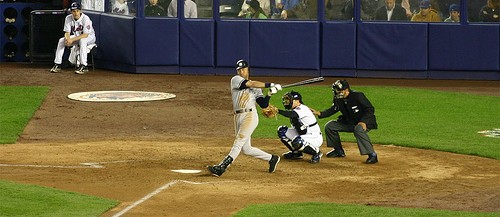 Several weeks ago, a subscriber emailed an article about Derek Jeter and his transformation this season. As I watched some videos of NBA players working out in the off-season, and thought about Dr. Marcus Elliott who told me that basketball players are the least self-aware athletes that he trains, I re-read the article.
Several weeks ago, a subscriber emailed an article about Derek Jeter and his transformation this season. As I watched some videos of NBA players working out in the off-season, and thought about Dr. Marcus Elliott who told me that basketball players are the least self-aware athletes that he trains, I re-read the article.
Jeter is one of the best baseball players of the last decade. However:
Jeter realized he had to alter his method of preparation. He realized he had to improve to meet his stated goal of playing well into his 40s, and of spending the majority of those years at the only position he’s ever wanted to hold.
Change. Change is difficult. However, when a player does not get the results that he desires, doing more of the same will not lead to the desired improvement. Many players – epecially young athletes – stay in the comfort zone and fail to make real improvements. Jeter embraced change to maintain his desired level of performance.
“So in his case we were looking at speed and agility. Our main focus was improving his defensive skills and first-step quickness.”
Riley discovered immediately why Jeter had little trouble making plays to his right, to his rear and toward the infield grass, and yet struggled when moving toward second base.
Jeter had limited ankle mobility and far less flexibility in his left hip than he did in his right, a condition not uncommon for a ballplayer hitting and throwing from the right side.
When sports scientists write about early specialization and overuse injuries, the injuries usually draw most of the attention. However, doing the same repetitive movements over and over (always throwing and batting right-handed) lead to strength, flexibility and mobility imbalances.
On the court, watch players when they run a line-drill (suicide). Most players will turn in the same direction every time: a right-handed player turns to his left, while a lefty turns to his right. For a right-handed athlete, almost all rotational movement occurs with the left leg as the front leg and the rotational movement is toward the left: hitting a tennis ball, swinging a golf club, throwing a baseball, etc. A right-handed player tends to be much slower when turnin to his right on a line-drill, which is why I tell players which way to turn so they practice turning in each direction rather than continually reinforcing their strengths.
(Another easy place to see rotational imbalances is a one-hand scissors dribble – a right-handed player will have difficulty with his left-hand because he cannot rotate as well, as quickly or as far to his right to receive the ball with his left hand.)
Great players correct these imbalances even though the work often seems elementary or like a step or two backward from their current level of performance.
“We were re-coaching his first step, over and over. I think he hated doing these drills at first, because it’s almost like reeducating a little kid. An accomplished athlete is like, I don’t want to do this because it makes me look stupid.’ And then suddenly, Derek was killing those drills.”
Great players do not worry about how they look. They concentrate on learning or improving the skill. Mistakes, failure or basic drills are a step toward the desired goal, not an indictment of the player’s talent level.
Teenagers often worry about their peers when training. They want to look talented or strong or advanced. They do not want to struggle in front of others or look weak, which is why individual workouts are often important in skill building, as it eliminates the peer pressure and the player can relax and concentrate on the drill or skill, not on performing for other players, coaches or onlookers.
If you want to be a great player, you will attack weaknesses with a great work ethic and not worry about how you look in the lerning process. The off-season is a time for development, not performance, and the great players use this time to prepare for greater performance during the season.
You must log in to post a comment. Log in now.